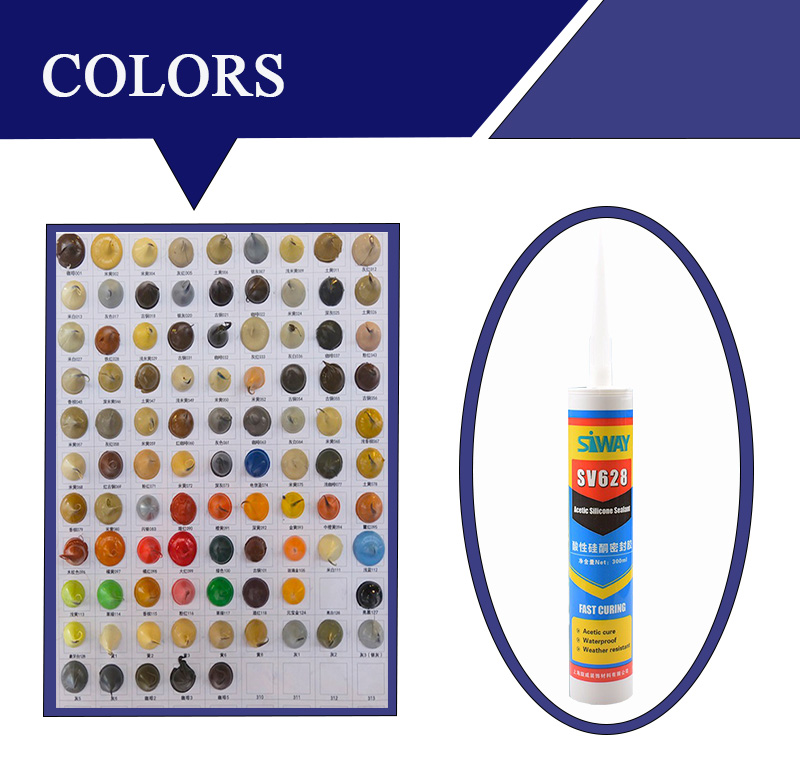What is silicone glass sealant?
Silicone sealant is a common and convenient adhesive in construction and daily life.
According to its curing mechanism and reaction characteristics, it can be divided into two types: one-component
and two-component.
1. One-component silicone sealant is cured by contacting moisture in the air and absorbing heat to
generate a cross-linking reaction, which is common in the market. A product, which is mostly used for
household decoration, kitchen, bathroom paste, sunshine plate glass paste, fish tank paste, glass curtain
wall, aluminum-plastic panel paste and other common civil projects.
2. The two-component silicone sealant is packaged and stored separately in two groups, A and B.
The A component is generally white, and the B component is black. The two components need to be
mixed for curing and bonding. This product is generally used in engineering such as deep processing of
insulating glass, curtain wall engineering construction, etc. It is a product that is easy to store and
has strong stability.


How to use silicone glass sealant?
1. Use:
The one-part silicone glass glue is ready to use, easily dispensed from the bottle with a glue gun, and can be trimmed with a spatula or wood chip.
2. Sticking time:
The curing process of silicone glue is developed from the surface inward, and the surface drying time and curing time of silicone rubber with different characteristics are different. Transparent glue should generally be within 5-10 minutes, neutral variegated glue should generally be within 30 minutes). If separation paper is used to cover an area, after applying the glue, be sure to remove it before the skin is formed.
3. Curing time:
The curing time of glass glue increases with the increase of bonding thickness. For example, acid glass glue with a thickness of 12mm may take 3-4 days to solidify, but within about 24 hours, the outer layer of 3mm has been cured. 20 psi peel strength after 72 hours at room temperature when bonding glass, metal or most woods.
If the place where the glass glue is used is partially or completely closed, then the curing time is determined by the tightness of the sealing. In an absolutely airtight place, it is possible to remain uncured forever. Increasing the temperature will soften the glass glue. The gap between metal and metal bonding surfaces should not exceed 25mm. In various bonding occasions, including airtight conditions, the bonding effect should be fully checked before the bonded equipment is used.
During the curing process of acid glass glue, there will be an odor due to the volatilization of acetic acid, which will disappear during the curing process, and there will be no peculiar smell after curing.
4. Bonding:
A. Completely wipe the metal and plastic surfaces to remove oil stains, and then use acetone to rinse the entire surface except the plastic, and the rubber surface should be sanded with sandpaper, and then wiped with acetone. When using acetone, observe the precautions for using this solvent.
B. Apply the glass glue evenly on the surface of the prepared object. If you want to bond the two surfaces, you can find the position of one side first, and then squeeze the other side with enough force to squeeze out the air, but pay attention to Do not squeeze out the glass glue.
C. Place the bonded device at room temperature and wait for the glass glue to cure.
5. Seal:
When silicone glass glue is used for sealing, also follow the above steps, squeeze the glass glue into the joint surface or gap, so that the glass glue can fully contact the surface.
6. Cleaning:
Before the glass glue is cured, it can be wiped off with a cloth or paper towel. After curing, it must be scraped off with a scraper or scrubbed with solvents such as xylene and acetone.
How long is the shelf life of silicone glass sealant?
1. Glass glue should be stored in a cool, dry place, below 30℃. The good quality acid glass glue can ensure the effective storage period of more than 12 months,
and the general acid glass glue can be stored for more than 6 months;
2. Neutral weather resistance and structural adhesive can guarantee a shelf life of more than 9 months. If the bottle has been opened, use it up within a short period of time.
If the glass glue is not used up, the plastic bottle must be sealed. When using it again, the bottle mouth should be unscrewed, and all blockages should be removed or
the bottle mouth should be replaced.
Post time: May-19-2022